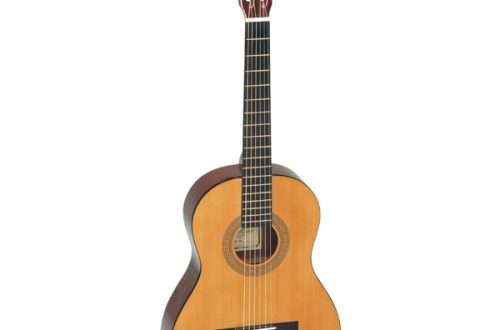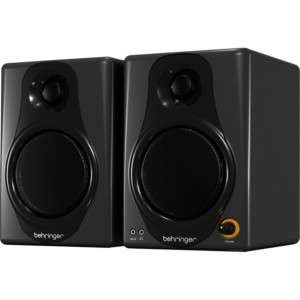
How to choose a mandolin
The mandolin is a stringed plucked instrument of the lute family. The Neapolitan mandolin, which became widespread in Italy in the 18th century, is considered the progenitor of modern varieties of this instrument. Today’s pear-shaped mandolins are most reminiscent of early Italian instruments in appearance and are especially popular with folk and classical music performers. From the middle of the 19th century, the mandolin practically disappeared from concert practice, and the rich repertoire written for it was forgotten.

Neapolitan mandolin
At the beginning of the 20th century, the mandolin regained popularity , which led to the emergence of various design options. A great contribution to the development of this instrument was made by American craftsmen, who were the first to make models with a flat soundboard (“flattops”) and a convex soundboard (“archtops”). The “fathers” of modern varieties of the mandolin – an important instrument in such styles of music as bluegrass , country – are Orville Gibson and his colleague, acoustic engineer Lloyd Loar. It was these two who invented the most common “Florentine” (or “Genoese”) model F mandolin today, as well as the pear-shaped model A mandolin. The design of most modern acoustic mandolins goes back to the very first models made at the Gibson manufactory.
In this article, the experts of the store “Student” will tell you how to choose the mandolin that you need, and not overpay at the same time.
Mandolin device
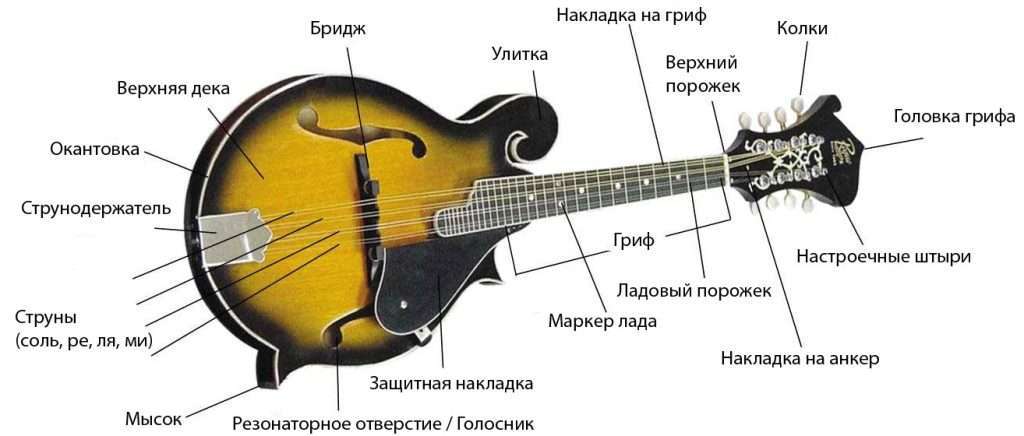
The headstock is the part to which the peg mechanism is attached .
Pegs are small rods used to hold and tension the strings.
The nut is the part that, in combination with the stringer and tailpiece, is responsible for the correct height of the strings above the neck .
Neck – a long, thin structural element, including a fretboard and sometimes an anchor (metal rod), which increases the strength of the neck and allows you to adjust the system.
Fretboard – an overlay with metal nut ( frets ) is glued to the neck of the neck . Pressing the strings to the corresponding frets allows you to extract a sound of a certain pitch.
Fret markers are round marks that make it easier for the performer to navigate the fretboard e. More often they look like simple dots, but sometimes they are made of decorative materials and serve as an additional decoration for the instrument.
Body – consists of upper and lower decks and shells. Top sounding board , often referred to as resonant , is responsible for the sound of the instrument and, depending on the model, is flat or curved, like a violin. The bottom deck can be flat or convex.
The snail , a purely decorative element, is found only in the F models.
Protective overlay (shell) – designed to protect the body so that the performer playing the instrument with the help of a plectrum does not scratch the top deck.
Resonator hole (voice box) – has a variety of shapes. The F model is equipped with “efs” (resonator holes in the form of the letter “f”), however, voices of any shape perform the same function – to absorb and give the sound amplified by the mandolin body back out.
Stringer ( bridge ) – transmits the vibration of the strings to the body of the instrument. Usually made of wood.
Tailpiece – As the name suggests, it holds the strings of the mandolin. Most often made of cast or stamped metal and decorated with decorative trim.
Enclosure types
Although the Model A and F mandolins do not sound very different, country and bluegrass players prefer the Model F. Let’s take a look at the types of mandolin bodies and the differences between them.
Model A: This includes virtually all teardrop and oval body mandolins (i.e., all non-round and non-F). The designation of the model was introduced by O. Gibson at the beginning of the 20th century. Often A models have curly soundboards, and sometimes even curved ones, like those of a violin. Model A mandolins with curved sides are sometimes erroneously called “flat” mandolins, as opposed to instruments with a round (pear-shaped) body. The design of some modern A models is more like a guitar. Due to the absence of the “snail” and “toe”, characteristic of the F model and carrying a decorative function, the A model is easier to manufacture and, accordingly, cheaper. Models A are preferred by performers of classical, Celtic and folk music.
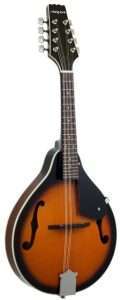
Mandolin ARIA AM-20
Model F: As mentioned above, Gibson began making F models at the beginning of the last century. Combining exquisite design and high quality, these mandolins belonged to the premium segment of the Gibson manufactory. The most famous instrument of this line was considered the F-5 model, developed by acoustic engineer Lloyd. Under his direct supervision, it was made in 1924-25. Today, the legendary mandolins with Loar’s personal autograph on the label are considered antiques and cost a lot of money.
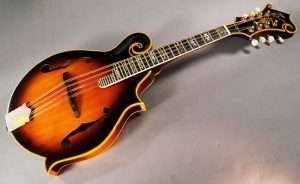
Gibson F5
Most current F models are more or less exact copies of this instrument. The resonator hole is made in the form of an oval or two letters “ef”, as in the F-5 model. Almost all F-mandolins are equipped with a sharp toe at the bottom, which both affects the sound and serves as an additional point of support for the musician in a sitting position. Some modern manufacturers have developed “daughter” models, both similar to and different from the original F. The Model F mandolin (often referred to as “Florentine” or “Genoese”) is a traditional instrument for bluegrass and country music players .
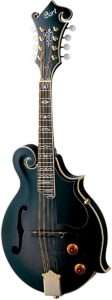
Mandolin CORT CM-F300E TBK
Pear-shaped mandolins: with a round, pear-shaped body, they are most reminiscent of their Italian predecessors, as well as the classical lute. The round mandolin is also called “Neapolitan”; there is also a colloquial name “potato”. The solid round mandolins are played by performers of classical music belonging to different eras: baroque, renaissance, etc. Due to the voluminous body, pear-shaped mandolins have a deeper and richer sound.
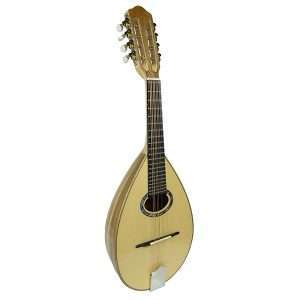
Mandolin Strunal Rossella
Construction and materials
The main material for the manufacture of the upper ( resonant ) deck of the mandolin, no doubt, is spruce wood . The dense structure of this tree provides a bright and clear mandolin sound, characteristic of other strings – guitar and violin. Spruce, like no other tree, conveys all the shades of performing technique. Due to the fact that high-quality spruce wood is a rare and expensive material, some manufacturers replace it with cedar or mahogany, which give a richer sound .
Top decks of the best mandolins are handmade from solid spruce and come in both figured and flat. The patterned texture of wood decorates the appearance of the instrument (although it also increases its value). Herringbone decks are made from two blocks of wood with the texture at a certain angle to the center of the block.
In cheaper instruments, the top is usually made of laminate , a layered, laminated wood that is often veneered on top with patterned veneers. Laminated decks are shaped by bending under pressure, which greatly reduces the cost of the production process. Although professionals favor instruments with solid spruce tops, mandolins with laminateddecks also provide acceptable sound quality and can be a good choice for beginning players.
For mandolins of the middle price segment, the top deck can be made of solid wood, and the sides and bottom deck can be laminated. This design compromise delivers good sound while keeping the price reasonable. Like its violin cousin, good quality mandolin sides and backs are made from solid maple, less often other hardwoods such as koa or mahogany are used.
The fretboard is usually made of rosewood or ebony . Both woods are very hard and have a smooth surface that allows for easy movement of the fingers over the frets . To stiffen the neck , as a rule, made of maple or mahogany , often from two parts glued together. (Unlike a top, a glued neck is considered a plus.) To avoid deformation, the component parts of the neck are positioned so that the wood pattern looks in opposite directions. Most often, the neck of a mandolin is reinforced with a steel rod – an anchor , which allows you to adjust the deflection of the neck .and thereby improve the sound of the instrument.
Unlike a guitar, a mandolin ‘s bridge (stringer) is not attached to the soundboard, but is fixed with the help of strings. Often it is made of ebony or rosewood. On an electric mandolin, the stringer is fitted with an electronic pickup to amplify the sound. The mechanics of the mandolin consists of a peg mechanism and a string holder (neck). Sturdy tuning pegs with a smooth tension mechanism are the key to the correct tuning of the mandolin and keeping the tuning during the game. A well-designed, well-designed neck locks the strings in place and contributes to good tone and sustain .y. Tailpieces are distinguished by a variety of designs and, in addition to the main one, often perform a decorative function.
Decorative trim has little to no effect on the sound quality, but it can affect the cost of the instrument and improve its appearance, delivering aesthetic pleasure to the owner. Typically, mandolin finishes include fretboard and headstock inlays with mother-of-pearl or abalone. Most often, inlay is performed in the form of traditional ornaments. Also, quite often, manufacturers imitate the “fern motifs” of the famous Gibson F-5 model.
Lacquering not only protects the mandolin from scratches, but also improves the appearance of the instrument, and also has some effect on the sound. The lacquer finish of the Model F mandolins is similar to that of a violin. Many mandolin connoisseurs note that a thin layer of nitrocellulose varnish gives the sound a special transparency and purity. However, other types of finishes are also used in the finishing, designed to emphasize the beauty of the texture of the wood, without affecting the timbre and richness of the sound.
Examples of mandolins
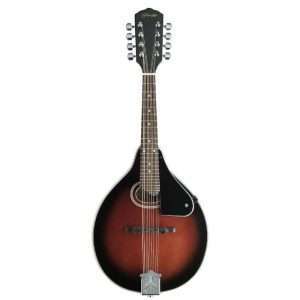 STAGG M30 | 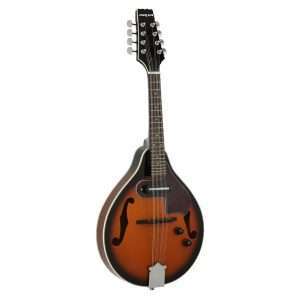 ARIA AM-20E |
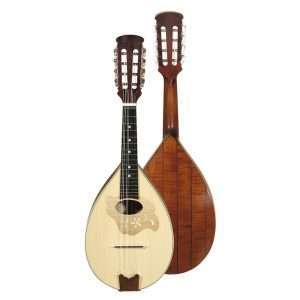 Hora M1086 |  Strunal Rossella |



